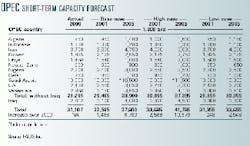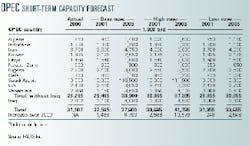This article is a latebreaking adjunct to the special report category.
The Organization of Petroleum Exporting Countries' productive capacity and capacity utilization have long been an indicator of the stability or vulnerability of the global oil market. Pundits have watched these capacity changes for years, and there has been a flood of interpretive analyses for decades.
Capacity is not equal to production. Can one have excess capacity and resist the temptation to cheat? Some have, and some have not. In the 1970s and 1980s, if OPEC capacity utilization exceeded 85%, that was the signal that the price was ready to move up. In the 1990s, OPEC capacity utilization was near its maximum, and the price did not move up. Clearly, the interpretation of the impact of capacity utilization on the oil market and oil prices had changed radically.
As OPEC nations placed quota limits on themselves and tried to raise prices, they faced severe competition from non-OPEC producers, gradually losing their market share. In addition, by closing the market to outside investments in some of the major producing countries-Iran, Iraq, Kuwait, Saudi Arabia, and Venezuela-OPEC capacity growth could not keep pace with world oil demand growth. As OPEC capacity stagnated, non-OPEC capacity grew consistently.
OPEC capacity today is lower than it was 20 years ago. Certainly, the higher prices in the past 2-3 years can be partially explained by the lack of excess capacity.
As demand grew to outpace OPEC capacity, many OPEC countries outside of Saudi Arabia ran out of excess capacity. OPEC cohesion is easy if there is no excess capacity to tempt members to cheat. If and when capacity substantially exceeds quota, cohesion will again face a serious test.
Change of heart
In the past few years, many OPEC countries that had closed their doors to foreign investment have had a change of heart. They watched non-OPEC producers take the new demand as OPEC sat by helplessly on massive proven reserves and vanishing excess capacities.
This change of heart is most significant. Iran and others, notably Iraq, Kuwait, and Saudi Arabia, have all initiated policies to allow foreign investment.
OPEC capacity in 2000 was estimated at just over 31 million b/d, while production was at a little over 28 million b/d (both figures include Iraq). This left more than 2.5 million b/d of excess capacity, of which Saudi Arabia accounted for more than two thirds of the total.
Therefore, aside from Saudi Arabia (and to a lesser extent Kuwait and Abu Dhabi), other OPEC countries were producing at near capacity and could not cheat, even if they wanted to. If for some reason OPEC fails to increase capacity in line with rising incremental world demand, even higher prices will appear as demand surpasses capacity. The importance of excess production capacity is to provide a buffer to prevent sharp in- creases in crude prices. The world and the industry in particular are happy to avoid such volatility. OPEC is the only group of countries that will not necessarily produce at full capacity-this is the key to OPEC's power as well as its dilemma of maintaining a respectable market share while keeping prices strong.
New paradigm
Currently, OPEC is open to new investment. International oil companies are now being invited back to invest in OPEC's upstream operations. As one country increases production capacity, others will follow in order to keep up. Basically, no one wants to see their "market share" of OPEC production decrease.
Certain countries have the capability to add relatively large volumes of capacity. The countries that stand to change the landscape are Algeria, Iran, Iraq, Kuwait, Saudi Arabia, and Venezuela.
Algeria is a prime example of the new approach to capacity addition. The country's capacity currently stands at 850,000 b/d, but that will increase by more than 500,000 b/d due to the investments of international oil companies (IOCs). Al- geria's quota was only 773,000 b/d as of Apr. 1, while in reality, 810,000 b/d was produced during the month of March. If this is any indication of how Algeria reacts to its given quota, it is highly unlikely that the country would be willing to shut in a major amount of excess capacity for the sake of the quotas. Indeed, almost every country with spare capacity overproduced beyond the quotas in first quarter 2001, including Saudi Arabia. Most still do.
Iran has huge potential to increase its capacity. If sanctions are removed sooner rather than later, and Iran permits in- creased onshore upstream development, production capacity could grow rapidly to well over 5 million b/d by 2005. Over the next 3 years, Bangestan (Ahwaz, Mansuri, and Abe Teymour) should add more than 500,000 b/d alone, assuming the current impasse over the new buy-back "risk-reward" structure is resolved. Even if US sanctions are continued, the country will still have relatively large capacity increases. Indeed, our base case shows Iran's production capacity rising to 4.75 million b/d by 2005.
Iraq remains the perpetual wild card. Before the Persian Gulf War, Iraq had plans to raise capacity to 5-6 million b/d. While this may eventually occur, we view 4 million b/d by 2005 as a more likely target. This assumes a relaxed version of the current sanctions, permitting Iraq to have a fully functioning oil industry with some level of international investment.
Kuwait is trying to open the market if it can first get past its own domestic political problems over allowing IOCs into the upstream activities. If the results of the parliamentary debate permit the entry of IOCs into the four northern fields, then eventually an additional 500,000 b/d of capacity by 2005 will be on the market.
As always, Saudi Arabia remains the heavyweight, beyond question. Current emphasis is on natural gas production and utilization, which will likely result in an increase in condensate production capacity of over 500,000 b/d by 2005. If and when the kingdom chooses to expand oil production capacity, then the sky is the limit.
Venezuela, under President Hugo Chavez, slashed exploration and production budgets at state oil company Petro- leos de Venezuela SA, which resulted in a major capacity drop. PDVSA is now moving to recover the lost capacity. PDVSA's projected budget over the next 5 years has grown considerably, and more than half of the capacity investment is planned to come from the private sector. The restructured PDVSA has eliminated many inefficiencies and intends to raise production capacity to 5.5 million b/d by 2005. Though 5.5 million b/d may be achievable, it is on the high side. We conservatively anticipate a production capacity of no more than 4.1 million b/d by 2005.
OPEC capacity forecast
The table shows our OPEC production capacity forecast through 2005. The base case has a 70% probability of occurring, and the other two cases each have a 15% probability.
The base case is quite robust, with average annual net capacity growth of well over 1 million b/d through 2005. This growth will be more than adequate to meet projected world demand growth through 2005 and should help curb the pressure on today's prices.
As can be seen from the table, OPEC capacity is likely to increase by nearly 1.5 million b/d in 2001.
Add a non-OPEC capacity increase of some 600,000 b/d forecast by the International Energy Agency, and the total capacity increase for 2001 will be around 2 million b/d.
The increase in total capacity is likely to be twice as big as the increase in global oil demand of less than 1 million b/d in 2001, though the timing of capacity additions may come too late in the year to weaken prices substantially.
In our base case, OPEC capacity rises by 5.6 million b/d during 2000-05, excluding Iraq. Our low case still sees growth of over 2 million b/d, and our high case shows growth of 9 million b/d.
Cyclical capacity
Our analysis shows that OPEC capacity has staged a quiet revolution, with substantial additions to production programmed to 2005. This is quite contrary to past trends of stagnating OPEC capacity numbers.
These changes have great consequences for the stability and level of oil prices. With OPEC and non-OPEC capacity additions of some 2 million b/d and weak demand in the short term, it is difficult to see how oil prices can be sustained at about $25/bbl for Dubai. Either supply growth must change or demand must increase much faster to keep prices high. Neither is likely in the short-to-medium term, and they are creating strong pressure for lower prices of $20/bbl. The lower prices should materialize by year- end or sometime in 2002.
Lower prices may in turn lead to another stagnation of OPEC capacity increases beyond 2005, indicating once again the cyclical nature of OPEC capacity movements.
The authors
Robert R. Smith is a senior associate at Fesharaki Associates Consulting & Technical Services (FACTS Inc.) and a researcher at the East-West Center in Honolulu. His research focus is on downstream oil and natural gas markets and energy policy issues east of the Suez Canal. He holds an MA in Asian studies from the University of Hawaii and a BA from the Johns Hopkins University.
Hassaan S. Vahidy holds an MA in economics from the University of Hawaii at Manoa and an MBA and a BS in engineering. He is currently a senior associate at FACTS Inc. and a researcher at the East-West Center in Honolulu, involved in downstream oil and gas research for the Asia-Pacific and Middle East regions. Prior to this, Vahidy worked for Royal Dutch/Shell in Pakistan.
Fereidun Fesharaki is president and founder of FACTS Inc. He also is a senior fellow at the East-West Center, Honolulu. Fesharaki received his PhD in economics from the University of Surrey, England. He then completed a visiting fellowship at Harvard University's Center for Middle Eastern Studies. In the late 1970s, he attended the Organization of Petroleum Exporting Countries' ministerial conferences as energy adviser to the prime minister of Iran.




